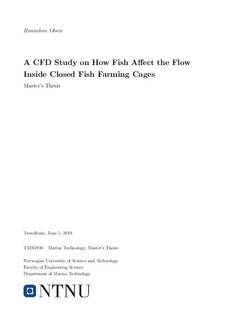| dc.contributor.advisor | Holm, Håvard | |
| dc.contributor.advisor | Mørch, Hans Jørgen Bjelke | |
| dc.contributor.author | Olsen, Hannelore | |
| dc.date.accessioned | 2019-10-17T14:02:25Z | |
| dc.date.available | 2019-10-17T14:02:25Z | |
| dc.date.issued | 2019 | |
| dc.identifier.uri | http://hdl.handle.net/11250/2622921 | |
| dc.description.abstract | En økende verdenspopulasjon har skapt problemer med å holde mat og levekår til alle på en bærekraftig måte. Det sies at akvakultur vil bli den fortest voksende og viktigste dyrematsektoren til å oppnå dette. Den nåværende produksjonsplattformen, basert på åpne systemer, er for dårlig til å opprettholde betydelig vekst, anerkjent miljøprestasjon og samfunnsforventninger. Derfor utvikles det nå ny akvakulturteknologi, for eksempel lukkede oppdrettsanlegg. For å kunne holde kontroll på faktorene i et lukket system er det behov for detaljerte strømningsberegninger. Computational Fluid Dynamics (CFD) erstatter modelltesting ved å være mer tids og kostnadseffektivt. Beregningene er for øvrig gjort uten å vurdere hvordan bevegelsen fra fisk vil påvirke strømningen inne i systemene. Hvorvidt fisk i lukkede oppdrettsanlegg vil redusere, øke eller ikke gjøre noe med strømningshastigheten til det omkringliggende vannet er derfor et omdiskutert tema. Hvordan påvirker fisken det omkringliggende vannet? Er det greit å neglisjere effekten av fisk når man analyserer strømningen i lukkede anlegg? Hvordan er resultatene sammenlignet med litteraturen? Dette er spørsmål vi har spurt oss selv gjennom den vitenskapelig forskningen gjort i denne oppgaven.
Trinnvis CFD-simuleringer av fisk og omgivende strømning har blitt utført for å identifisere om effekter fra fisk i lukkede oppdrettsanlegg er ubetydelige. Hvert trinn i CFD-tilnærmingen bygger på påliteligheten og gyldigheten til det forrige. STAR-CCM+ simulerer det laminære og turbulente grensesjiktet over en flat plate i parallell strømning med høy nøyaktighet. Gjennomføringen av fiskebevegelsen viste seg også å være av god korrespondanse med ligningen for bevegelsen. Det konkluderes at fisk påvirker strømningen i lukkede oppdrettsanlegg ved å øke trykket for høyere fisketetthet og mindre system. Dette innebærer at fiskebiomassen vil redusere hastigheten i et system med konstant trykk. Dette støttes av litteraturen. Hvorvidt effektene er ubetydelige er det ikke mulig å si før videre utredning har blitt utført. | |
| dc.description.abstract | An increasing world population has created the problem of providing food and livelihood to all in a sustainable way. It is believed that aquaculture will be the fastest growing and most important animal-food sector in achieving this. The current production platforms, based on open systems, are too weak to sustain significant growth, recognized environmental performance and societal expectations. Therefore, new aquaculture technology, for instance closed fish farming cages, are being developed. To be able to control the environmental factors inside a closed fish farming cage, detailed flow calculations are needed. Computational Fluid Dynamics (CFD) methods replace model testing to be more time and cost efficient. The calculations are done, however, without considering how the motion of fish will affect the flow inside the systems.
Whether fish in closed fish farming cages will reduce, increase or do nothing to the flow velocity of the surrounding water is a topic of discussion. How do fish affect the surrounding water? Is it okay to neglect the effects from fish when analyzing the flow in closed fish farming cages? How are the results compared to the literature? These are questions we have been asking ourselves through the scientific research done in this thesis.
Stepwise CFD simulations of fish and its surrounding flow have been conducted to identify if the effects from fish in closed fish farming cages are negligible. Each step in the CFD approach builds upon the reliability and validity of the previous one. It is found that STAR-CCM+ simulates the laminar and turbulent boundary layer over a flat smooth plate in parallel flow with high accuracy. The implementation of the fish motion also turned out to be of good correspondence to the equation for its motion. It is concluded that fish are affecting the flow in closed fish farming cages by increasing the pressure for higher fish density and smaller system. This implies that the fish biomass will reduce the velocity in a system of constant pressure, which is supported by the literature. Whether the effects are negligible is not possible to say until further investigation has been conducted. | |
| dc.language | eng | |
| dc.publisher | NTNU | |
| dc.title | Et CFD studie om hvordan fisk påvirker strømningen inne i lukkede oppdrettsanlegg | |
| dc.type | Master thesis | |
